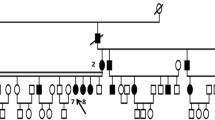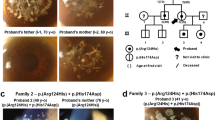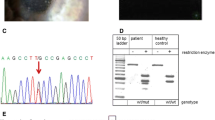Abstract
Purpose
This study is to summarize the concurrent keratoconus (KC) and granular corneal dystrophy (GCD) phenotype and identify the underlying genetic cause in a 23-year-old male patient.
Methods
A detailed family history and clinical data from the patient and his parents were collected by ophthalmologic examination. The candidate genes were captured and sequenced by targeted next-generation sequencing, and the results were confirmed by Sanger sequencing.
Results
The proband was clinically diagnosed as a case of concurrent KC and GCD, which is a very rare presentation. His father and grandmother were diagnosed as GCD in both eyes. There was no character of KC in his father’s and grandmother’s eyes. A heterozygous TGFBI mutation in exon 4 (c.370G > A) was identified in the proband, which was predicted to generate a missense mutation (p.R124H). The mutation also existed in his father and grandmother. A heterozygous KRT12 mutation in exon 8 (c.1456-1457ins GTA) was identified in the proband, which was predicted to generate an insert mutation and created a premature termination codon. The mutation did not exist in his father and grandmother. The two mutations did not exist in his mother and 200 unrelated normal controls.
Conclusions
KC can co-exist with GCD. The missense mutation (c.370G > A) in the TGFBI gene and insert mutation (c.1456-1457ins GAT) in the KRT12 gene were identified in a 23-year-old male patient with concurrent KC and GCD.







Similar content being viewed by others

References
Orucoglu F, Toker E (2016) A novel scoring system for distinguishing keratoconus from normal eyes. Cont Lens Anterior Eye 39:369–374
Rabinowitz YS (1998) Keratoconus. Surv Ophthalmol 42:297–319
Brown DJ, Lin B, Chwa M, Atilano SR, Kim DW, Kenney MC (2004) Elements of the nitric oxide pathway can degrade TIMP-1 and increase gelatinase activity. Mol Vis 10:281–288
Poulaki V, Colby K (2008) Genetics of anterior and stromal corneal dystrophies. Semin Ophthalmol 23:9–17
Wollensak G, Green WR, Temprano J (2002) Keratoconus associated with corneal granular dystrophy in a patient of Italian origin. Cornea 21:121–122
Mitsui M, Sakimoto T, Sawa M, Katami M (1998) Familial case of keratoconus with corneal granular dystrophy. Jpn J Ophthalmol 42:385–388
Rho CR, Park JH, Jung YH, Kim MS (2014) A case of concomitant keratoconus and granular corneal dystrophy type II. Cont Lens Anterior Eye 37:314–316
Dangra KL, Das M, Periasamy S, Prajna NV (2016) Bilateral atypical granular corneal dystrophy associated with unilateral keratoconus in a male child. Middle East Afr J Ophthalmol 23:262–264
Holland EJ, Daya SM, Stone EM, Folberg R, Dobler AA, Cameron JD, Doughman DJ (1992) Avellino corneal dystrophy. Clinical manifestations and natural history. Ophthalmology 99:1564–1568
Escribano J, Hernando N, Ghosh S, Crabb J, Coca-Prados M (1994) cDNA from human ocular ciliary epithelium homologous to beta ig-h3 is preferentially expressed as an extracellular protein in the corneal epithelium. J Cell Physiol 160:511–521
Boutboul S, Black GC, Moore JE, Sinton J, Menasche M, Munier FL, Laroche L, Abitbol M, Schorderet DF (2006) A subset of patients with epithelial basement membrane corneal dystrophy have mutations in TGFBI/BIGH3. Hum Mutat 27:553–557
Piao MZ, Zhou XT, Wu LC, Chu RY (2012) Arg555Gln mutation of TGFBI gene in geographical-type reis-bucklers corneal dystrophy in a Chinese family. J Int Med Res 40:1149–1155
Hieda O, Kawasaki S, Wakimasu K, Yamasaki K, Inatomi T, Kinoshita S (2013) Clinical outcomes of phototherapeutic keratectomy in eyes with Thiel-Behnke corneal dystrophy. Am J Ophthalmol 155:66–72
Zhong X, Chen S, Huang W, Yang J, Chen X, Zhou Y, Zhou Q, Wang Y (2010) Novel and known mutations of TGFBI, their genotype-phenotype correlation and structural modeling in 3 Chinese families with lattice corneal dystrophy. Mol Vis 16:224–230
Zhao SJ, Zhu YN, Shentu XC, Miao Q (2013) Chinese family with atypical granular corneal dystrophy type I caused by the typical R555W mutation in TGFBI. Int J Ophthalmol 6:458–462
Li Y, Li T, Song XS, Li JZ, Wu QS, Li HY (2012) TGFBI and CHST6 gene analysis in Chinese stromal corneal dystrophies. Int J Ophthalmol 5:301–306
Weiss JS, Moller HU, Lisch W, Kinoshita S, Aldave AJ, Belin MW, Kivela T, Busin M, Munier FL, Seitz B, Sutphin J, Bredrup C, Mannis MJ, Rapuano CJ, Van Rij G, Kim EK, Klintworth GK (2008) The IC3D classification of the corneal dystrophies. Cornea 27(Suppl 2):S1–83
Yang J, Han X, Huang D, Yu L, Zhu Y, Tong Y, Zhu B, Li C, Weng M, Ma X (2010) Analysis of TGFBI gene mutations in Chinese patients with corneal dystrophies and review of the literature. Mol Vis 16:1186–1193
Takacs L, Csutak A, Balazs E, Modis L Jr, Berta A (1999) Expression of betaig-h3 is lower than normal in keratoconus corneas but increases with scarring. Cornea 18:599–605
Vincent AL, Rootman D, Munier FL, Heon E (2003) A molecular perspective on corneal dystrophies. Dev Ophthalmol 37:50–66
Cremona FA, Ghosheh FR, Rapuano CJ, Eagle RC Jr, Hammersmith KM, Laibson PR, Ayres BD, Cohen EJ (2009) Keratoconus associated with other corneal dystrophies. Cornea 28:127–135
Ogasawara M, Matsumoto Y, Hayashi T, Ohno K, Yamada H, Kawakita T, Dogru M, Shimazaki J, Tsubota K, Tsuneoka H (2014) KRT12 mutations and in vivo confocal microscopy in two Japanese families with Meesmann corneal dystrophy. Am J Ophthalmol 157:93–102
Kao WW, Liu CY, Converse RL, Shiraishi A, Kao CW, Ishizaki M, Doetschman T, Duffy J (1996) Keratin 12-deficient mice have fragile corneal epithelia. Invest Ophthalmol Vis Sci 37:2572–2584
Roy S, LaFramboise WA, Nikiforov YE, Nikiforova MN, Routbort MJ, Pfeifer J, Nagarajan R, Carter AB, Pantanowitz L (2016) Next-generation sequencing informatics: challenges and strategies for implementation in a clinical environment. Arch Pathol Lab Med 140:958–975
Davies WI, Downes SM, Fu JK, Shanks ME, Copley RR, Lise S, Ramsden SC, Black GC, Gibson K, Foster RG, Hankins MW, Nemeth AH (2012) Next-generation sequencing in health-care delivery: lessons from the functional analysis of rhodopsin. Genet Med 14:891–899
Acknowledgements
We would like to express our gratitude to the participating family. For the data set used to filter variants, we thank the Single Nucleotide Polymorphism database, 1000 genome project, HapMap 8 database, and the YH database.
Author information
Authors and Affiliations
Corresponding author
Ethics declarations
Funding
The National Natural Science Foundation of China provided financial support in the form of funds from the National Natural Science Foundation of China (81300742). The Department of Science Technology of Shandong Shi Nan District provided financial support in the form of the Science and Technology Foundation of Shi Nan District, Qingdao, Shandong Province, China (2015–06-020-YY). The sponsor had no role in the design or conduct of this research.
Conflict of interest
All authors certify that they have no affiliations with or involvement in any organization or entity with any financial interest (such as honoraria; educational grants; participation in speakers’ bureaus; membership, employment, consultancies, stock ownership, or other equity interest; and expert testimony or patent-licensing arrangements), or non-financial interest (such as personal or professional relationships, affiliations, knowledge or beliefs) in the subject matter or materials discussed in this manuscript.
Ethical approval
All procedures performed in studies involving human participants were in accordance with the ethical standards of the institutional and/or national research committee and with the 1964 Helsinki Declaration and its later amendments or comparable ethical standards.
Informed consent
Informed consent was obtained from all individual participants included in the study.
Rights and permissions
About this article
Cite this article
Du, X., Chen, P. & Sun, D. Mutation analysis of TGFBI and KRT12 in a case of concomitant keratoconus and granular corneal dystrophy. Graefes Arch Clin Exp Ophthalmol 255, 1779–1786 (2017). https://doi.org/10.1007/s00417-017-3699-5
Received:
Revised:
Accepted:
Published:
Issue Date:
DOI: https://doi.org/10.1007/s00417-017-3699-5



